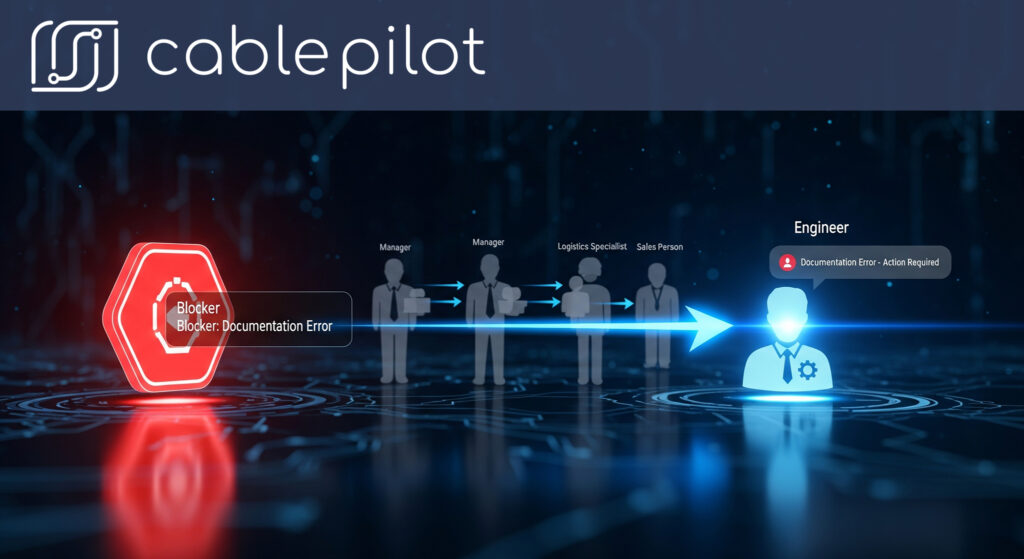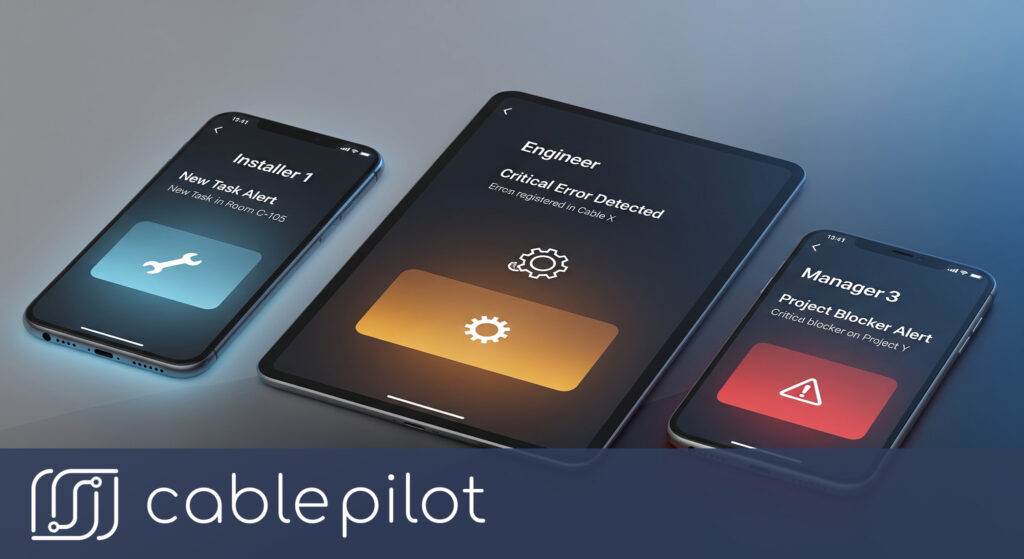Is your email inbox the control center for your project, or is it a digital graveyard where critical problems go to die?
For Project Managers and Area Supervisors, the daily reality is a constant flood of shipyard communication from dozens of channels—emails, text messages, verbal updates on the deck, notes scribbled in meetings. You are the human hub, responsible for filtering this chaotic noise, identifying the important signals, and manually relaying them to the right people.
But the system is breaking. An installer tells you about a problem with a piece of equipment, but you get pulled into another urgent issue and forget to pass it on. A critical email from a supplier gets buried under a hundred other messages. The result is always the same: a preventable problem escalates into a costly crisis. A full day of team downtime. A missed deadline. A budget overrun. All because the right information didn’t get to the right person at the right time.

The problem isn’t that issues arise; they always will. The problem is that we find out about them with a fatal delay. This article will deconstruct the true cost of this chaotic communication and prove that a shift to an automated, intelligent construction notification system is the key to transforming your management style from reactive firefighting to proactive problem-solving.
The Cost of Silence: How Information Lag Destroys Profitability
Every minute that a critical piece of information is stuck in transit—in an unread email, a forgotten verbal conversation, or a messy text chain—it creates an “information lag.” This lag is not a trivial inconvenience in shipyard communication; it is a direct and measurable drain on your project’s finances. It is the invisible source of your biggest headaches.
Let’s trace a typical, costly failure:
- 10:00 AM: An installer discovers that the newly delivered electrical panel is missing the correct type of cable glands for the specified shielded cables. He can’t proceed. He finds his Area Supervisor, who is busy with another team, and quickly explains the problem.
- 10:05 AM: The Area Supervisor makes a mental note to email the Design Engineer, but is immediately pulled into a safety inspection.
- 11:30 AM: The Area Supervisor finally gets back to his office and sends an email to the Engineer with the subject “Issue with Panel C-402.”
- 1:30 PM: The Engineer, returning from lunch and a series of meetings, finally sees the email. She needs to check the original specification and the supplier’s cut sheet.
- 2:30 PM: The Engineer confirms the discrepancy and sends a proposed solution back to the Area Supervisor.
- 3:30 PM: The Area Supervisor, now on the other side of the shipyard, finally reads the email and begins organizing the on-site modification.
In this common scenario for shipyard communication, it has taken over five hours for the problem to be formally acknowledged and a solution to be put in motion. For those five hours, the entire installation team has been idle or performing low-value tasks. You have paid a full day’s wages for zero progress. This is the real-world cost of a communication system that relies on manual handoffs. The “information lag” converted your payroll directly into wasted money.

From Noise to Signal: The Anatomy of a Smart Notification For Proactive Project Management
The solution is not to send more emails or create more group chats. That only adds to the noise. The solution is to replace the chaotic noise with targeted, intelligent signals. An effective shipyard communication system is not about more communication; it’s about smarter communication.
This is where a modern, integrated AI-based digital platform Cable Pilot changes the game. It doesn’t just store data; it actively monitors events and pushes critical information to the right people, at the right time. This is the essence of proactive project management.
A smart notification system is built on three key principles:
- It’s Automated: Notifications are not sent by people; they are triggered by events in the system. There is no “forgetting to pass on the message” because the system is the one sending it.
- It’s Context-Aware: The system understands what happened. A change in a document is different from a blocker on site, and the notification reflects that context.
- It’s Role-Based: The system understands who needs to know. A quality issue doesn’t get sent to the procurement team. A design question doesn’t get sent to every contractor on the project.
Let’s revisit our failed scenario, this time with an intelligent notification system:
- 10:00 AM: The installer discovers the problem. He opens his mobile app, scans the QR code on the panel, and logs a “Blocker” with the type “Equipment Non-conformance.”
- 10:00:01 AM: The system, recognizing that a blocker of this type requires engineering input, instantly sends a notification (via email, SMS, or in-app alert) directly to the responsible Design Engineer.
- 10:05 AM: The Engineer receives the alert on her phone, immediately accesses the linked digital object for the panel, sees the photos uploaded by the installer, and starts working on a solution.
The information lag has been reduced from over five hours to five minutes. A full day of team downtime has been saved. This isn’t a small improvement for shipyard communication; it’s a fundamental change in the operational physics of your project and important step for proactive project management.
Your Personal Assistant: Notifications for Every Role
A flexible, configurable notification system becomes an indispensable assistant for every member of the project team, filtering out the noise and allowing them to focus on what matters for risk prevention.
- For the Area Supervisor: Instead of constantly chasing status updates, he receives a live feed of progress in his zone.
- Notification: “Steel contractor has marked cable trays in Compartment B-102 as ‘Work Complete’.” He now knows he needs to schedule the inspector.
- Notification: “Installer has logged a ‘Blocker – Access Denied’ in Compartment D-301.” He knows exactly where to go to solve a problem, without having to hunt for it.
He can now manage by exception, dynamically allocating his teams to open work fronts and immediately addressing roadblocks, dramatically improving the operational efficiency of his shipbuilding team.
- For the Design Engineer: She is freed from a cluttered inbox and can focus on design.
- Notification: “A ‘Request for Information’ has been logged against Drawing A-1138.” She gets a direct, targeted alert about a specific query related to her work, with all the context she needs.
- Notification: “QC Inspector has flagged a ‘Design Discrepancy’ on Equipment P-50.” She is immediately aware of a potential issue, allowing her to address it before it gets replicated.
- For the Project Manager: He can escape the tyranny of micro-management and focus on the big picture. He can configure high-level, automated “escalation” rules.
- Notification: “A critical blocker on the main engine installation has been open for more than 24 hours without a status change.” He now knows he needs to intervene personally.
- Notification: “The overall progress on the ‘Navigation’ system has not advanced in 72 hours.” He can see a high-level trend that indicates a systemic problem, prompting a strategic investigation.
He is no longer managing the project by reading yesterday’s news. He is managing the live project, armed with the signals that tell him exactly where his attention is needed most.
Conclusion: Proactive Project Management Is Proactive Shipyard Communication
In the complex, fast-moving world of Shipbuilding 4.0, you cannot have proactive management without proactive communication. The traditional methods of verbal updates and email chains are fundamentally reactive. They guarantee an information lag, and that lag is where your project’s time and money disappear.

A shift to a platform with an automated, intelligent construction notification system is a strategic imperative. It’s the digital nervous system that connects the entire project, ensuring that every problem is met with an immediate, targeted response. It reduces downtime, minimizes errors, eliminates finger-pointing, and builds a culture of accountability.
This is how you stop managing the chaos and start proactive project management. You stop being a human message router and become a true shipbuilding project leader. You engineer the delays and miscommunications out of your process, creating a more predictable, more efficient, and ultimately more profitable operation.
Ready to transform your shipyard’s communication from chaotic noise to intelligent signals? Request a demo to see a modern notification system in action.
